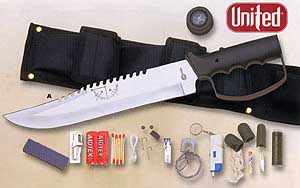Featured Member Video
Survival TarpMore Videos by IA Woodsman
View larger or ask the author a question.
View all wilderness survival videos
Recent Forum Posts 
Come Join the Discussion Today!
Our site has been mentioned in:
U.S. News and World Report
Best of the Web - Site of the Week 8/6/01
Discovery Channel Canada
One Week in the Wilderness
USA Today
Hot Sites 08/08/2005
Hantavirus
Alternative names: hemorrhagic fever, Black Creek Canal virus, Sin Nombre virus Type of infection: viral Incubation period: between 1 and 8 weeks, more typically 2 to 4 weeks Mortality rate: from 1% to 40%, depending on specific strain Vector: rats, mice or other small rodents (bites or contact with urine or feces)There are many strains of hantaviruses, and not all will make humans ill. Of the many variations, there are 2 that result in serious disease in humans: hantavirus hemorrhagic fever with renal syndrome (HFRS), and hantavirus pulmonary syndrome (HPS). The first is more common in Asia and Europe, whereas you're more likely to find the second in North and South America. Though both are caused by similar viruses, they present as two very distinctive diseases.
HistoryThese diseases are named for the Hantan River in South Korea, where one of the first outbreaks happened. As the medical community learned about the variations, further discoveries came later. HFRS was identified in the 1970s, but HPS wasn't isolated until 1993 in the United States. An outbreak of HPS happened in the Four Corners region of the USA, which led to its discovery.
Catching HantavirusYou won't be able to catch any form of hantavirus from another person, but if there are infected rodent droppings in and around your home, it will seem to spread through your family group. If there are areas in your living quarters contaminated with droppings or other rodent waste, people can get sick without even knowing they came in contact with anything risky.
You can become ill from breathing in infected fecal dust or from a rodent bite. Any food that may be contaminated by rodents can spread the disease if eaten. The main method of transmission is from feces and urine, not bites though.
The specific rodent species will vary by region. The white-footed mouse may carry HPS in the New York region of the USA, but it's the cotton rat that is the vector in the southern states. But it would be the Norway rat or striped field mouse that carries HFRS.
Signs & SymptomsThough related, the two hantavirus variations present quite differently.
For HFRS, the early symptoms include headaches, stomach pain, fever, chills, nausea and blurry vision. As the disease progresses, there can be diarrhea, back pains, unexplained bruising or bleeding, and some respiratory problems. From there, you'll get dropping blood pressure, rapid heart beat, excessive urination and finally full kidney failure. The mortality rate for HFR is relatively low, ranging from 1 to 15%.
As you can probably imagine, the symptoms for HPS focus more on the respiratory system. There will be coughing, headache, fever, and shortness of breath. Fluid soon builds up in the lungs, and that leads to pulmonary failure. This form of hantavirus has a mortality rate around 40%, even with treatment.
TreatmentThere is no treatment for any form of hantavirus. The only treatment is to control and counter the symptoms as they come up, to allow the patient to fight the disease themselves. If medical facilities are available, kidney dialysis (for HFRS) or a mechanical respirator (for HPS) can help a patient survive the final stages to eventually overcome their disease.
PreventionEliminate any rodent populations around your living areas, and wear protective gear (mask and gloves) when cleaning up any feces or handling dead rats or mice. Traps and poison should be kept on hand in case you do get rodents in your home.
Risk AssessmentCases of hantavirus infection crop up across North America though it would not be considered a common disease by any means.
Ultimate Survival Knife & Kit |
List Price: 61.99 Our Price: 39.95 |
This 15 inch survival knife with drop point blade features a thick quality stainless steel blade with serrated top edge. Textured and ribbed solid metal handle and guard. Nylon sheath. Survival kit includes a hollow grip with a compass top to store items within the knife itself, as well as additional pouches on the sheath to hold the rest. Complete survival kit. Click Here to Buy the Survival Knife Now. |
|

